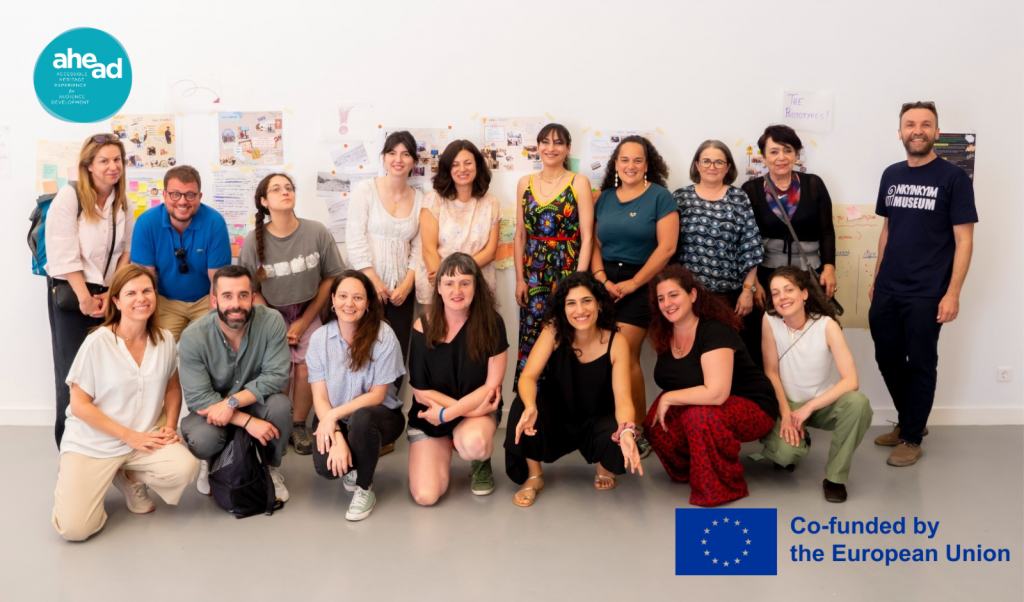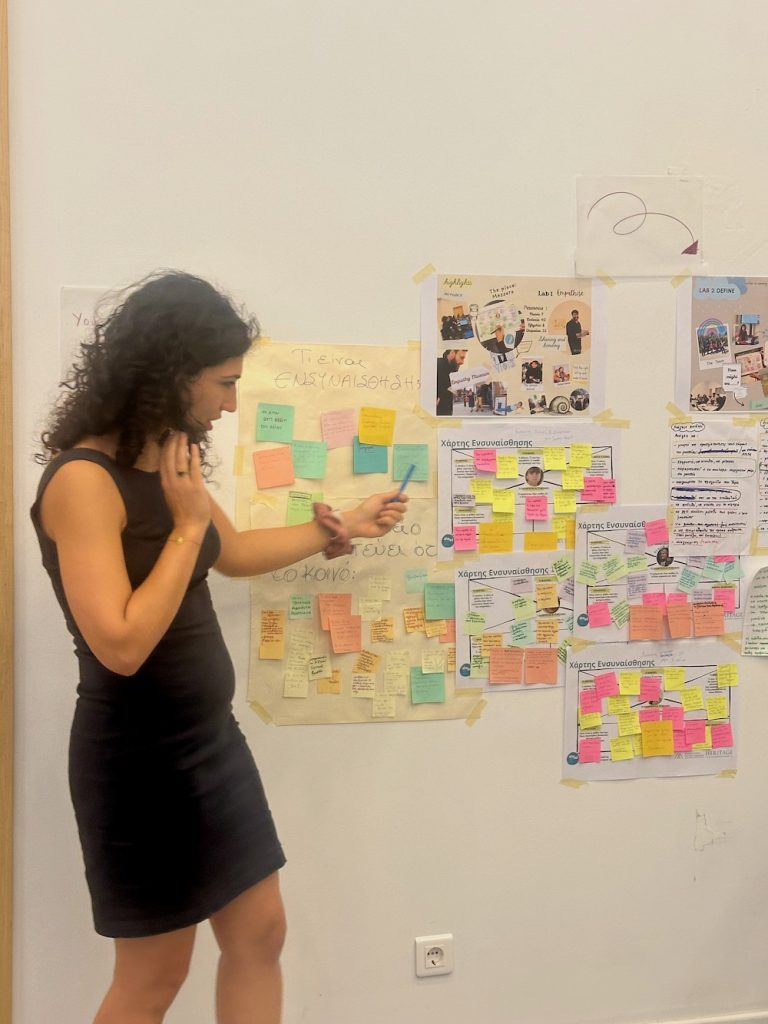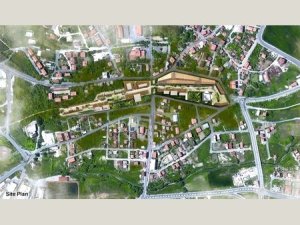: Field Study Projects
From Memory to Momentum: AHEAD Study Visit in Crete
From May 21st to 23rd, 2025, HERITΛGE and the Archaeological Museum of Mesara welcomed partners from across Europe for the second international AHEAD project Study Visit, a key milestone in the project’s mission to foster innovative, audience-centred cultural experiences. The three-day gathering hosted by the Museum (the project’s Greek Hub), proved a dynamic space for reflection, testing, and exchange of ideas across borders and communities.
The AHEAD team along with local heritage professionals and Elektra Angelopoulou – the artist selected to co-create work for the Greek hub- worked to validate and give feedback on the prototypes developed through the AHEAD methodology — a process designed to help cultural institutions understand their audiences, co-create with them, and embed those practices into their operations.
Two Prototypes, Two Publics
The Greek Hub focused on two distinct but equally vital local audiences: children and adults, engaging each group in a meaningful journey through AHEAD’s empathise–define–ideate–prototype–test framework.
Prototype I: Children’s Voices in the Museum
HERITΛGE and the Museum partnered with two local primary schools to involve young learners in the creative process. With the participation of artist/performer Elektra Angelopoulou, and through structured activities aligned with the AHEAD methodology, the children explored the museum’s collection and selected their favourite objects.From these choices, the children developed their own narratives — imaginative stories, reflections, and personal interpretations inspired by the artefacts.
In centering children’s voices, the museum embraces storytelling not just as education, but as connection — bridging past and present through creativity, wonder, and the eyes of a new generation.
Prototype II: Community, Connection, and Co-governance
In parallel, HERITΛGE invited local adults to participate in a series of reflective workshops, beginning with the sharing of memories, lived experiences, and deep-rooted connections to the Messara landscape — a place where archaeology, history, and daily life are inextricably linked.
These sessions revealed a strong sense of local pride, but also a disconnect: many felt the museum, though geographically close, was distant in spirit — shaped by state institutions without enough input from those who live nearby. In response, the prototype developed with this audience is the creation of a “Friends of the Museum of Mesara” Association.
This initiative aims to:
– Strengthen community engagement with the museum
– Amplify local voices in decision-making processes
– Support the museum’s role in driving tourism and sustainable local growth
– Provide a formal channel for co-creating future experiences and exhibitions
From Testing to Transformation
Both prototypes were presented to AHEAD consortium members during the Study Visit. Feedback sessions, held at the Archaeological Museum and visits to the area and its archaeological sites Gortyna and Phaistos, allowed partners to gain and exchange insights, and consider how these approaches might be adapted across other contexts.
The feedback underscored the importance of:
- Deep listening and long-term community involvement
- Rethinking traditional exchanges between museums and local communities
- Fostering sustainable links between heritage, education, and local development
- Working with the AHEAD methodology and returning to it as often as necessary throughout the lifetime of a project.
The prototypes — still in development — will be officially launched in September 2025, during a dedicated event that will also feature a site-specific performance by Elektra Angelopoulou, created in collaboration with the Mesara community.
Looking Ahead
This second Study Visit demonstrated the power of co-creation, memory, and local agency in shaping meaningful cultural heritage experiences. By validating the Greek Hub’s work and drawing lessons from the field, partners left Messara not only inspired, but equipped with ideas they could bring back to their own communities.
Next up for AHEAD: Study Visit 3 in Altamira, Spain — where a new chapter of audience-centred innovation is already unfolding.
AHEAD is co-funded by the European Union. To learn more about the AHEAD methodology or how to join the AHEAD network visit the project website and explore the learning resources, manifesto, and upcoming events.
A new version of our archaeological ethnography and heritage summer school
By Dr. Aris Anagnostopoulos
It is almost a decade since we first had the idea to create a summer school for archaeological ethnography and heritage in the village of Gonies, in Crete. From the beginning, we had two basic ideas in our minds: one, that this would not be simply a school transferred into a remote place, but it would be a way to teach by doing research and by engaging with local populations. The other was that we had to find a way to involve locals as experts in their own heritage in the process. It was a very instructive experience for all of us, not only for its successes, but also because it made us think again about the way we work and the way we think about heritage, collaboration, and local communities in a more global way.
In this new version of our Engaging Communities in Cultural Heritage summer school, we have moved to an entirely different setting, the island of Paros, in close collaboration with a grassroots festival, the Paros Festival. Besides the change of location, the form of the summer school itself has changed towards a more hybrid form. Faced with the pandemic and lockdowns, we took the whole process online, but at the same time sought to keep a close link with the locality, even remotely.
We realized that remote work, especially with increased online presence of local places, may bring unexpected insights to the whole process of research and engagement. We already had evidence that the online presence of heritage projects increases their accountability and can serve as a research and engagement field of its own. At the same time, online work may bring together participants from a wide variety of backgrounds and contexts. This is important to the way we approach community engagement in heritage, as something that does not follow a blueprint or a set of ready-made techniques, but as an open-ended response to the needs and capacities of local places, groups, and stakeholders. At the same time, however, we have had to deal with the limitations of online work, especially structural inequalities in access and infrastructure. While we have found ways around this, such as the development of asynchronous modules that people can access in their own time, we are now geared towards creating hybrid forms for our workshops, that combine physical presence and online components, as a way to counter these inequalities.
Dr. Aris Anagnostopoulos is an Head of Community Engagment at HERITΛGE , Honorary Lecturer at University of Kent and Researcher for the Ottoman Heritages project .
Community Engagement Summer School page: https://heritagemanagement.org/training/summer-schools/engagingcommunities/
“Weaving” the textile heritage of Gonies in Crete
Written by Katerina Konstantinou
The “loom-project” was centered on women’s weaving practices and drew upon art and ethnographic methods. The first seeds of this project were planted in the summer of 2015 at the 2nd Archaeological Ethnography Summer School organized by the Heritage Management Organization in Gonies, Crete, which I was attending as a postgraduate student. My contribution to the school’s fieldwork, conducted within the broader context of the Three Peak Sanctuaries of Central Crete research program, focused on unraveling the history of weaving in Gonies. A year later, Alexia Karavela, an Athens-based visual artist, joined me to further investigate the multitude of stories, reminiscences and songs related to woven textiles and their production. This was made possible due to HMO’s decision to host an artist-in-residence program alongside the 3rd Archaeological Ethnography Summer School.
My preliminary fieldwork on weaving raised many issues regarding the textile heritage and its multiple uses in the past, present, and future. Whereas non-mechanized cloth production was largely abandoned in Greece after WWII due to the industrial production of textiles, looms remained in use in Crete to meet growing demand for souvenirs in the early 1970’s. During this period, textiles were mass-produced throughout the island and were sold by wholesalers all around Greece. It was within this context that weaving provided a significant source of income in Gonies from the late 1970’s until 2000.
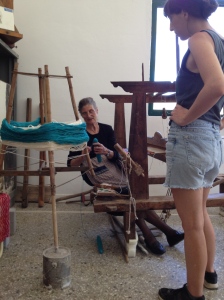 Material evidence of this relatively recent past abounds in Gonies. Nearly every house has its own loom. Many textiles, collected and preserved mainly by elderly women, have survived long past their period of use. These collections provide a rich source of information concerning the relation between memory and the material world. For instance, the textiles recall memories of the past in which almost every woman was weaving day and night.
Material evidence of this relatively recent past abounds in Gonies. Nearly every house has its own loom. Many textiles, collected and preserved mainly by elderly women, have survived long past their period of use. These collections provide a rich source of information concerning the relation between memory and the material world. For instance, the textiles recall memories of the past in which almost every woman was weaving day and night.
The idea of continuing the research next year was born out of this relation between material and memory. In order to deal with the material nature of textile production and bridge the gap between research and practice, I invited Alexia Karavela to join me. Alexia has been concerned with ethnographic themes and issues of materiality, social memory and identities in her work as a visual artist (http://alekakaravela.blogspot.gr/). With a particular focus on the recent political history of Greece, she critically comments on the everyday life that continued alongside great political events of the 1980’s and 1990’s. In one of her previous works, presented for her Master of Fine Arts graduation in 2015, entitled “I Hira” (“The Hand”), she explored aspects of social memory in the manual production of textiles. Installed alongside other materials, Alexia used an old, very simple loom and textiles woven with unconventional materials such as magnetic tapes to refer to history-writing processes.
Her weaving experience as well as her critical thinking towards cultural heritage and material culture additionally inspired me to design a community engagement art project that combined contemporary art practices and fieldwork methods for the summer of 2016. Alexia was to apply her artistic practices on the fieldwork, and I was to coordinate the project and collect the ethnographic information. We were accommodated by the team of anthropologists and archaeologists, Aris Anagnostopoulos, Lena Stefanou and Celine Murphy, who were running the 3rd Summer School of Archaeological Ethnography in July of 2016.
Shortly after our arrival to Gonies, we transformed a hall of the abandoned school into an open studio, and a local man donated an old loom to Alexia. The loom was restored with the help of some locals and put to working condition. Having thus occupied the school and set up the loom, we set about encouraging locals to help weave a collective textile.

The community of Gonies enthusiastically responded to our call and the school was infused with new life as locals gathered daily to weave or to simply spend time with us. As one local would pick up where another had left off, all who participated left their mark on what became a collective, community rug. Locals of all ages had an eagerness to weave that had many different motivations: such as a desire to experience the past, to understand this old tradition, or even to reignite potentially profitable local industry. In all cases the experience of weaving in a loom was perceived as performing part of cultural heritage. On our part, weaving served as a point of departure by which to communicate with people and observe them interact with locally-significant objects. These interactions provided a rich source of ethnographic data not only regarding what people remember but also how they remember and how they forget.
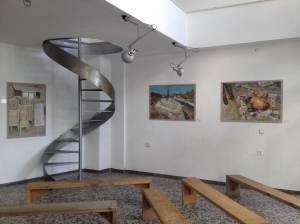
Later on during this one month stay in Gonies, a second loom was brought to our studio in the school by local women. This loom was dismantled, moved in and restored again to weave a triopatitero, a weaving technique that is considered to be characteristic of the island of Crete and requires particular skills and knowledge. The energy with which elderly women commandeered the project made us step aside at times and watch them act. After all the “loom-project” aimed at making the local community define what was there to be preserved as part of their textile heritage.
Moving beyond the traditional fieldwork methods required that we collaborate with the locals and therefore made us reconsider the ways we do ethnography. Rather than imposing out own research framework, we hosted them in an open studio that was designed to inspire some artistic production through which Goniotes were actively involved in defining the textile heritage of their village by nominating heritage items and by ensuring local knowledge. We allowed locals to decide on the project, to a great extent, and thus avoided playing an over-determining role in the interaction. We found that artist Alexia Karavela’s presence considerably facilitated local involvement in interpreting their heritage. Her artistic approach to the field of ethnographic research elucidated issues relevant to the poetics of fieldwork. Such an approach strengthens the creative and metaphorical dimension of the discourse produced through ethnography and challenges the ethnographer’s conception of the ways we conduct fieldwork.
The “loom-project” incorporated a series of paintings produced by Alexia as a way to analyze and interpret the ethnographic material gathered in Gonies. An exhibition was put together almost a year later in DA, an artist-run space in Heraklio, which is the closest city to Gonies, where most Goniotes live during the winter. Through this exhibition, Alexia proved that artists can use their position to bring new dynamics and practices not only to the production of ethnographic data but also to its interpretation and representation.
Although ostensibly investigating the position of textile heritage in Gonies as cultural and economic resources, the “loom-project” was largely focused on an exploration of new ethnographic methods. Equally significant was the investigation of new ways of representing ethnographic knowledge. Several issues regarding the relationship of art and anthropology were raised during all phases of the “loom-project” such as the appropriation of methodologies and subjects between them that demand further consideration by the actors of the project.
 Katerina Konstantinou is a PhD candidate in the Department of Social Anthropology at Panteion University. She is an art historian and holds an MA in Curating. Her research interests focus on the intersection of the fields of contemporary arts, anthropology and archaeology. She has participated in several research programs, such as the Three Peak Sanctuaries in Central Crete in Gonies. She has worked for museums and cultural institutions. She has participated in conferences and she has published texts in collective volumes and art magazines.
Katerina Konstantinou is a PhD candidate in the Department of Social Anthropology at Panteion University. She is an art historian and holds an MA in Curating. Her research interests focus on the intersection of the fields of contemporary arts, anthropology and archaeology. She has participated in several research programs, such as the Three Peak Sanctuaries in Central Crete in Gonies. She has worked for museums and cultural institutions. She has participated in conferences and she has published texts in collective volumes and art magazines.
Visiting the National Museum of the American Indian
The Great Plains of the northwestern United States and southern Canada occupy parts of Montana, Wyoming, North Dakota, South Dakota and Nebraska, as well as parts of Canadian provinces Alberta and Saskatchewan. This area once comprised one of the largest prairie grassland ecosystems in the world. Despite habitat loss, species decline and human destruction, opportunities exist to conserve and restore large areas of this unique habitat and the cultural heritage it has contributed to western expansion of frontier America.
(more…)
The Arnavutkoy Museum: Hadimkoy Station Challenge
General Information on the Project
Hadimkoy is a small Turkish city 44 km from Istanbul which belongs to the Arnavutkoy municipality. The city, like the rest of the broader Arnavutkoy area, is included in the greater development plan of the Istanbul Metropolitan Municipality (Istanbul&Istanbul Metropolitan Municipality, 2011), which is planning the expansion and reorganization of Istanbul’s city borders, the formulation of satellite and smaller urban centers, and the expansion of the existing urban facilities such as: public transportation, green spaces and metropolitan parks, highways and a new airport. Consequently, the change of the environmental, social and structural characteristics of the Arnavutkoy district is expected.
Considering those future alternations, the rapid growth in the broader area of the Arnavutkoy municipality, the expansion of the urban zones and the increase of inhabitants, as described above, the formation of a museum which is going to collect, document, interpret, preserve, and promote the historical facts and traditions of the Arnavutkoy region seems crucial. That led to the decision, to turn two buildings of the Old Railway Infrastructure located in Hadimkoy city into a museum named Arnavutkoy Museum – Hadimkoy Station.
The museum will include:
A Local Cultural Landscape and Human Activity History Museum, where the permanent collection will be held; and
A Periodical Exhibition Venue, where temporary exhibitions will be hosted. Their subject could vary, but still should be related to the museum purposes.
The subject of the Arnavutkoy Museum – Hadimkoy Station will be the presentation of the local history and lifestyle in time through the relation and interaction of human activity and landscape. On one hand, the way that the environment set the conditions in which local activity developed (i.e. the Terkos Lake water supply system) and on the other hand, the way the people transformed the landscape, adapting it to their activities and needs (Aksoy 2012; 5th International Architecture Biennale, 2012). Respectively, its mission will be to demonstrate and narrate to the public this landscape and social change depended on the cultural activity. To reveal the natural, demographic, ethnic, economic, religious, architectural and urban alternations that formed Arnavutkoy’s region contemporary characteristics (UNESCO, 2008, 2014; Kartaler 2012).
A Museum without a Collection, a Reversed Process
It’s common sense that when speaking about a museum, one of the most important components is its collection. In the Arnavutkoy Museum – Hadimkoy Station the material gathered so far is historical data concerning the previous function of the buildings; facts related with the railway system, maps which locate Hadimkoy and older villages of the Arnavutkoy area during time, as some demographic information concerning the population which lived in the area before the population exchange in 1923-24 (Stavridou, 1991; Meellas 2000). Hence, a material collection is not gathered yet. Research results will be exhibited within the museum premises, and through public awareness more tangible and intangible assets are expected to be gathered. So, how can a museum without tangible collection function and what is its importance?
The most fascinating fact in the Hadimkoy Station Museum case is that the present of the Arnavutkoy district is the collection which should be gathered. Realizing that in a few years the area will be changed from the ground up, now is a unique opportunity to collect objects and testimonies which in a few years will belong to the past, and nothing will remind Arnavutkoy’s current aspect.
Archaeologists usually gather findings which they can’t explain or identify, because they belong to a civilization which doesn’t exist anymore. So they come up with assumptions or hypothesis, concerning their function and utility. Respectively the social and economic activity remains mainly an interpreted assumption (Pearce, 1994) .
In this case there is the opportunity not to have assumptions about the aspect of the area, but real testimonies considering all the important facts which are indicating the environmental, social, cultural, and economic activity in Arnavutkoy. This is the reason why it is proposed the collection gathering to be implemented vice-versa. Starting from year 0, which is today, the collection should be gathered and interpreted backwards. The residents of Arnavutkoy – Hadimkoy, especially the elders are the most important component in this effort, as they are carrying all the important knowledge connected with everyday activities and landscape alternations (Jones 1997).
Bibliography
5th International Architecture Biennale (2012), “Arnavutkoy, Istanbul, Making City/Kent Yapmak”, Rotterdam
Acela Meellas (2000), “Kadikoy and Derkos Metropolis Stamps”, Foundation of the Hellenic World, Athens, pages: 19-20, 271, 342-348, 433
Aksoy Asu (2012), ‘Atelier Arnavutköy: strategies for Istanbul’s sustainability‘, International Conference, Italy
B.Th. Stavridou (1991), [professor in the Theological school of Khalkis], “The metropolis of Chalcedon, Derkos, and Prince Islands”, for the Ecumenical Patriarchate, published by Kyriakides Bros, Thessaloniki, pages 196 – 203
Istanbul&Istanbul Metropolitan Municipality (2011), ‘Facts & Figures about Turkey and İstanbul, İstanbul a vibrant city of a thriving country‘.
Pearce Susan (1994) [editor], ‘Interpreting Objects and Collections‘, Routledge, UK.
Siân Jones (1997), ‘The Archaeology of Ethnicity, Constructing Identities in the Past and Present‘, Routledge, UK.
UNESCO (2008), ’Guidelines On The Inscription Of Specific Types Of Properties On The World Heritage List’, UNESCO World Heritage Centre, France
UNESCO, Cultural Lanscape, available in: http://whc.unesco.org/en/culturallandscape/ , accessed 04/04/2014
Yesim Kartaler [editor] (2012), “Making a Sustainable City, The Arnavutkoy Approach”, Architecture Workroom Brussels, IABR, Belgium
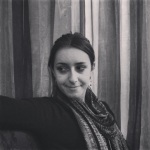 Theodora Tsitoura is an alumna student of MA in Heritage Management 2012, with a Bachelor in International and European Economic Studies (AUEB). Currently she is a volunteer in the Exile Museum of Athens and in Diadrasis NGO. Theodora’s main interests are Heritage Management, Dark Heritage, Urban Heritage and Cross-Institutional Interdisciplinary Collaboration management.
Theodora Tsitoura is an alumna student of MA in Heritage Management 2012, with a Bachelor in International and European Economic Studies (AUEB). Currently she is a volunteer in the Exile Museum of Athens and in Diadrasis NGO. Theodora’s main interests are Heritage Management, Dark Heritage, Urban Heritage and Cross-Institutional Interdisciplinary Collaboration management.

